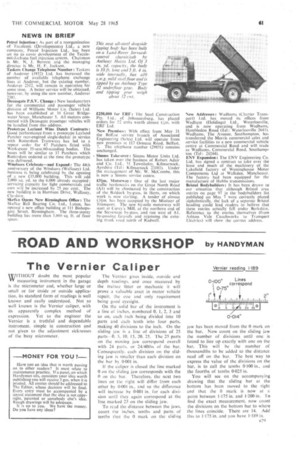ROAD AND WORKSHOP by HANDYMAN The Vernier Caliper Vernier reading
Page 63

If you've noticed an error in this article please click here to report it so we can fix it.
1.189 WITHOUT doubt the most popular VV measuring instrument in the garage is the micrometer and, whether large or small or for inside or outside application, its standard form of readings is well known and easily r understood. Not so well known is the Vernier: caliper, with its apparently complex method of expression. Yet to the engineer the Vernier is a truthful and dependable instrument, simple in construction and not given to the adjustment siCknesses of the busy micrometer. The Vernier gives inside, outside and 'depth readings, and once mastered by the trainee fitter or mechanic it will prove a valuable asset in motor vehicle repair, the one and only requirement being good eyesight.
On the solid bar of the instrument is a line of inches, numbered 0, 1, 2, 3 and so on, each inch being divided into 1.0 parts and each tenth into four parts, making 40 divisions to the inch. On the sliding jaw is a line of divisions of 25 parts--O. 5. JO. 15, 20, 25. The 25 parts On the moving jaw correspond overall with 24 parts. or 24/40ths of the bar. Consequently, each division on the sliding jaw is smaller than each division on the bar by 0.001 in.
If the caliper is closed the line marked 0 on the sliding jaw corresponds with the 0 on the bar. Therefore, the next two lines on the right will differ from each other by 0.001 in„ and so the difference will increase by 0-001 in. for each division until they again correspond at the line marked 25 on the sliding jaw.
To read the distance between the jaws, count the inches, tenths and parts, of tenths that the 0 mark on the sliding jaw has been moved from the 0 mark on the bar. Now count on the sliding jaw the number of divisions until one is found to line up exactly with one on the bar. This will be the number of thousandths to be added to the distance read off on the bar. The best way to express the value of the divisions on the bar, is to call the tenths 0.100 in., and the fourths of tenths 0-025 in.
You will see on the accompanying drawing that the sliding bar at the bottom has been moved to the right and that the 0 mark is now at a point between 1.175 in, and 1200. in. To find the exact measurement, now count the divisions on the bottom bar to where the lines coincide. There are 14. Add this to 1-175 in. and you have 1.189 in.








































































































































































